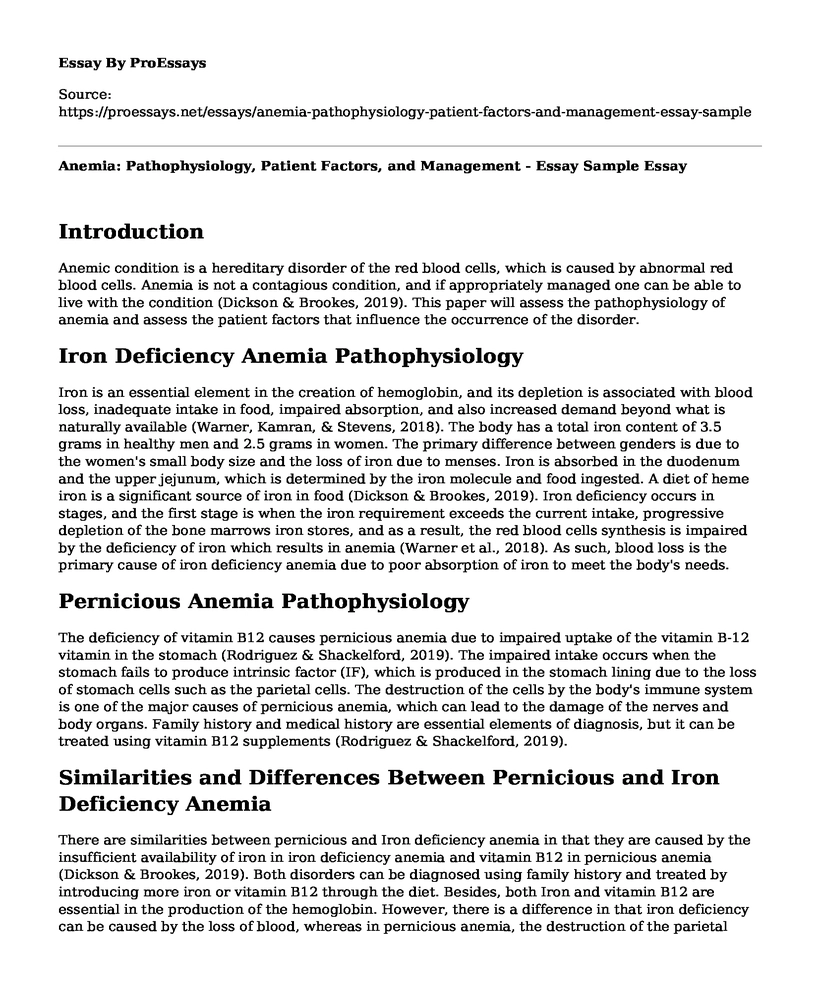Introduction
Anemic condition is a hereditary disorder of the red blood cells, which is caused by abnormal red blood cells. Anemia is not a contagious condition, and if appropriately managed one can be able to live with the condition (Dickson & Brookes, 2019). This paper will assess the pathophysiology of anemia and assess the patient factors that influence the occurrence of the disorder.
Iron Deficiency Anemia Pathophysiology
Iron is an essential element in the creation of hemoglobin, and its depletion is associated with blood loss, inadequate intake in food, impaired absorption, and also increased demand beyond what is naturally available (Warner, Kamran, & Stevens, 2018). The body has a total iron content of 3.5 grams in healthy men and 2.5 grams in women. The primary difference between genders is due to the women's small body size and the loss of iron due to menses. Iron is absorbed in the duodenum and the upper jejunum, which is determined by the iron molecule and food ingested. A diet of heme iron is a significant source of iron in food (Dickson & Brookes, 2019). Iron deficiency occurs in stages, and the first stage is when the iron requirement exceeds the current intake, progressive depletion of the bone marrows iron stores, and as a result, the red blood cells synthesis is impaired by the deficiency of iron which results in anemia (Warner et al., 2018). As such, blood loss is the primary cause of iron deficiency anemia due to poor absorption of iron to meet the body's needs.
Pernicious Anemia Pathophysiology
The deficiency of vitamin B12 causes pernicious anemia due to impaired uptake of the vitamin B-12 vitamin in the stomach (Rodriguez & Shackelford, 2019). The impaired intake occurs when the stomach fails to produce intrinsic factor (IF), which is produced in the stomach lining due to the loss of stomach cells such as the parietal cells. The destruction of the cells by the body's immune system is one of the major causes of pernicious anemia, which can lead to the damage of the nerves and body organs. Family history and medical history are essential elements of diagnosis, but it can be treated using vitamin B12 supplements (Rodriguez & Shackelford, 2019).
Similarities and Differences Between Pernicious and Iron Deficiency Anemia
There are similarities between pernicious and Iron deficiency anemia in that they are caused by the insufficient availability of iron in iron deficiency anemia and vitamin B12 in pernicious anemia (Dickson & Brookes, 2019). Both disorders can be diagnosed using family history and treated by introducing more iron or vitamin B12 through the diet. Besides, both Iron and vitamin B12 are essential in the production of the hemoglobin. However, there is a difference in that iron deficiency can be caused by the loss of blood, whereas in pernicious anemia, the destruction of the parietal cells, which aid the absorption of vitamin B12, is associated with the anemia. As such, genetic factors resulting in one's immunity destroying the parietal cells leads to pernicious anemia (Rodriguez & Shackelford, 2019).
Patient Factors
Whereas genetics are associated with the pernicious anemia, gender and behavior are associated with iron insufficiency anemia. Women are more likely to suffer from iron insufficiency anemia due to monthly menses, which results in the loss of iron. At the same time, a lifestyle prone to blood loss due to accidents increases the risk of iron insufficiency anemia.
References
Dickson, E. A., & Brookes, M. J. (2019). Common causes of iron deficiency anemia in gastroenterology patients. Medicine. Retrieved from https://www.sciencedirect.com/science/article/pii/S135730391930012X
Rodriguez, N. M., & Shackelford, K. S. (2019). Pernicious Anemia. In StatPearls [Internet]. StatPearls Publishing. Retrieved from https://www.ncbi.nlm.nih.gov/books/NBK540989/
Warner, M., Kamran, M., & Stevens, L. (2018). Anemia, iron deficiency. StatPearls. Retrieved from http://knowledge.statpearls.com/chapter/adolescent%20medicine/23767
Cite this page
Anemia: Pathophysiology, Patient Factors, and Management - Essay Sample. (2023, Feb 27). Retrieved from https://proessays.net/essays/anemia-pathophysiology-patient-factors-and-management-essay-sample
If you are the original author of this essay and no longer wish to have it published on the ProEssays website, please click below to request its removal:
- The Role of the Advanced Practice Nurse - Essay Sample
- Effectiveness of Public Awareness Education in Reducing Stigma in the UK Paper Example
- Professional Identity and Stewardship as a Neurosurgical Nursing Specialist Paper Example
- Community Healthcare: Stakeholders' Performance, Safety & Competence - Essay Sample
- Nursing Leaders: Educating Nurses for Evidence-Based Practice in Hospitals - Research Paper
- Essay Sample on Understanding AIDS: Causes, Risks & Prevention
- Essay Sample on Psychosocial Factors Impacting Health Care Professional Wellbeing & Patient Education







